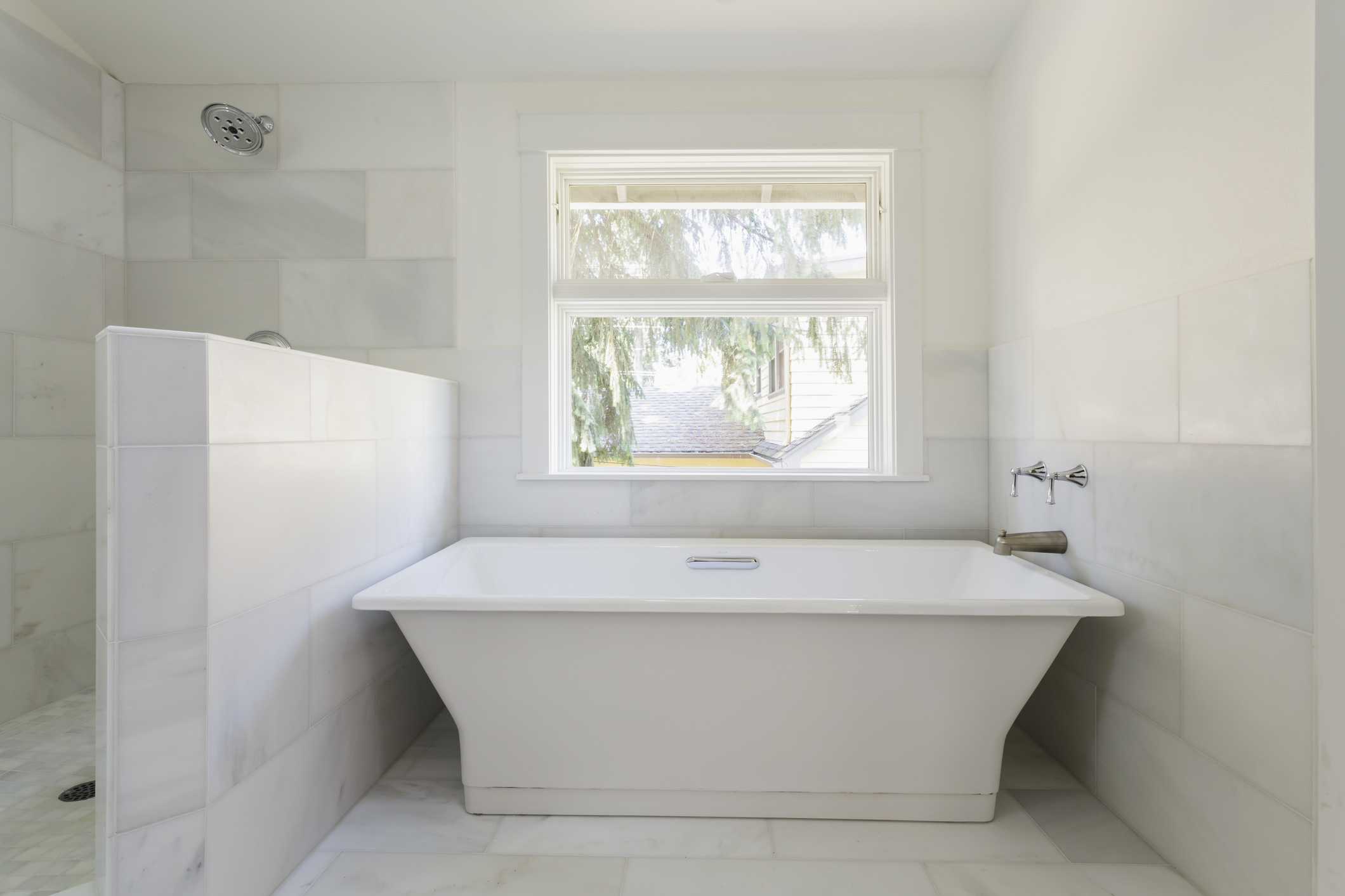Bathroom remodel costs: Average spend, how to budget, and ways to save
Planning your bathroom remodel costs is the first step to upgrading your current space. Here's an overview of average costs, plus expert tips for budgeting and saving.


Whether your bathroom needs a complete do-over with demolition down to the studs, or you just want to update the fixtures and flooring, a bathroom remodel requires perfect planning to stay within budget and get the job done in a timely manner. After all, most homeowners can’t do without their bathroom for any length of time.
According to Remodeling magazine’s cost vs. value report 2020, the average mid-range bathroom renovation costs $21,377, and yield a 64 percent ROI. However, costs could be as low as $2,500, according to the internet services company Angie’s List, depending on the scope of the job.
“The biggest budget factor is whether the project is a gut to remodel or simply a facelift to replace the fixtures and update the look,” says Gabby Koontz, kitchen and bath designer for Classic Kitchen and Bath in Harrisonburg, Virginia.
Planning a bathroom remodel of your own? Below, we're running through the biggest factors that impact bathroom remodel costs, how to budget for your bathroom remodel, plus ways to save money if you're renovating on a dime.
Factors that impact bathroom remodel costs
Labor—According to Angie’s List, the cost of labor is about 50 percent of the job. So, including things that require more labor, like moving plumbing lines, will drive up the cost. For this reason, Gabby recommends keeping the fixtures in the same location when remodeling a small bathroom or powder room.
Materials—Materials come in a wide range of quality and cost and contribute to the overall budget. For instance, natural stone floor and wall tiles cost more to install and stone countertops are more expensive than solid surfaces. Gabby recommends deciding what you want to spend on materials (flooring, wall tile, a vanity, faucets, etc.), then looking at options that fall within your budget.
Features—“Often there’s work to do behind the wall that homeowners don’t realize, which drives up the cost,” says Gabby. She explains that including a rainfall showerhead includes more than the cost of the showerhead itself. Behind the walls are pipes, valves, and diverters that increase that cost. Other common features that increase overall cost include freestanding bathtubs, wall-hung toilets, custom cabinetry, and smart fixtures.
Get small space home decor ideas, celeb inspiration, DIY tips and more, straight to your inbox!
Other factors to consider
A few more things that will impact the cost of your bathroom remodel include:
Permits—Your contractor will know if building permits are required for your particular job. If you’re doing it yourself, consult with your local building official.
Repairs—If you discover water damage after tearing out old tile or fixtures, the cost of repair will increase the cost of the project. Finding mold may require hiring a mold removal specialist, too.
Location—Where you live and where your bathroom is located in your home will also impact your overall cost. Second-story bathrooms may incur more labor cost than those on the lower level, for example, because of accessibility to plumbing and electric lines, as well as the extra effort to maneuver large and heavy fixtures up a flight of stairs.
Change requests—If you change your mind about something your contractor has already completed, you will incur additional costs for the changes.
Disposals—Your local waste management department may charge for disposing of construction waste. Contractors typically include this charge into their estimate but a DIY-er will have to pay this out-of-pocket.
Creating a budget for your bathroom remodel
Creating a budget for your remodel job begins with the end goal. Can you envision what your bathroom will look like when it’s complete? Do you want to make it larger? Include both a shower and a tub? Will you need to tear down walls?
If you’re just giving your bathroom an update, HomeAdvisor breaks down the costs according to the replacement you're planning to do. For example, the cost of materials and labor to install a new bathtub range from a low of $400-1,500 to $6,000-8,000 on the high end. Using this information, you can estimate a budget for each item you want to replace, before consulting with a designer or bath showroom for local pricing.
Once you have a vision in place, make a list of “must-haves” and a list of “nice to have.” Knowing your priorities will help you make choices when or if you need to trim the budget. Partnering with a contractor or designer will make those choices easier.
“We regularly take continuing education courses to learn about new products and features,” says Gabby. Having that knowledge is indispensable when you’re faced with the decision between two items that may or may not be comparable.
Ways to save money on a bathroom remodel
Do it yourself—Find a contractor who will let you do some of the work yourself. If you’re comfortable with demolition and painting, for instance, ask the contractor if he’s willing to work with you.
Choose alternative materials—Tile costs more than a fiberglass shower insert. If a tile shower isn’t on your list of “must-haves” consider going with an alternative. Or, suggests Gabby, use a fiberglass panel partway up the wall and tile at the top.
Upcycle fixtures—Use a vintage or antique cabinet, protected with a marine-grade finish, for your vanity. Finish the look with a vessel bowl-style sink on top.
Reuse fixtures—You can makeover your bathroom without replacing the tub, sink, and toilet. If a fixture works properly, consider keeping it or refinishing it.
Complete the work in stages—Once you get your bathroom operational, you may choose to upgrade additional features after saving a little more money. Changing out light fixtures, towel bars, or a faucet are easy upgrades you can do at a later date. Just make sure that you think about the timeline of your updates, say, so you don't have to undo a fresh coat of paint in six months when you decide to relocate the wall sconces.
Use kits or stock pieces—According to HomeAdvisor, custom work can cost as much as ten times that of off-the-shelf furnishings from a local retailer. To save money, choose a shower kit rather than custom tilework or stock cabinets over custom woodworking.
Choosing a contractor
If you've never remodeled a bathroom, or have a hard time picturing what you want your finished space to look like, consider hiring a bathroom designer. Hiring a bathroom designer to manage your project can save you money in the long run, since they can help you avoid costly mistakes and help you create a space you'll love for the long-haul. Oftentimes, designers can also recommend top-quality contractors in your area, too. But if you choose to not hire a designer, you’ll need to find a reputable contractor. The best place to start is with your friends.
If you know someone who’s remodeled their bathroom recently, ask them who they worked with. Look up their suggestions online and read the contractors’ reviews and testimonials to help you narrow it down.
If you can’t get any recommendations from those you know, check reputable sites like HomeAdvisor, Angie’s List, or our Find a Builder Guide. Once you narrow it down to one or two to interview, ask to see their current licenses and certificates of insurance.
Remodeling a bathroom should be a fun and rewarding experience. In fact, the National Association of the Remodeling Industry’s (NARI) 2019 Remodeling Impact Report gives a bathroom remodel a Joy Score of 9.3 /10, with 80 percent of homeowners feeling a major sense of accomplishment over their project. Following these tips for developing a budget and staying within it will be the icing on the cake.
Carol J. Alexander writes website copy, blog posts, and feature articles on home remodeling and construction topics from her home in the Shenandoah Valley of Virginia. In addition to Real Homes, notable clients include, This Old House, Family Handyman, and Florida Roofing magazine.
